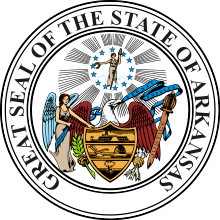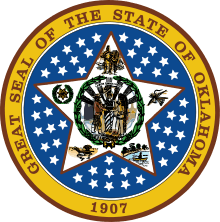Arkansas Territory
| Territory of Arkansas | |||||
| Organized incorporated territory of the United States | |||||
| |||||
.svg.png) | |||||
| Capital | Arkansas Post (1819–21) Little Rock (1821–36) 35°N 95°W / 35°N 95°WCoordinates: 35°N 95°W / 35°N 95°W | ||||
| Government | Organized incorporated territory | ||||
| Governor | |||||
| • | 1819–1824 | James Miller | |||
| • | 1825–1828 | George Izard | |||
| • | 1829–1835 | John Pope | |||
| • | 1835–1836 | William Savin Fulton | |||
| History | |||||
| • | Established | March 2, 1819 | |||
| • | Statehood | June 15, 1836 | |||
| History of Arkansas |
|---|
|
|
|
The Territory of Arkansas, initially organized as the Territory of Arkansaw,[1] was an organized incorporated territory of the United States that existed from March 2, 1819 until June 15, 1836, when the final extent of the territory was admitted to the Union as the State of Arkansas.[2]
History
Arkansaw Territory (later Arkansas Territory) was created from the portion of the Missouri Territory lying south of a point on the Mississippi River at 36 degrees north latitude running west to the St. Francis River, then followed the river to 36 degrees 30 minutes north latitude, then west to the territorial boundary. This included all of the present state of Oklahoma south of the parallel 36°30' north. The westernmost portion of the territory was removed on November 15, 1824, and a second westernmost portion was removed on May 6, 1828, reducing the territory to the extent of the present state of Arkansas.
Originally the western border of Missouri was intended to go due south to the Red River. During negotiations with the Choctaw in 1820, however, Andrew Jackson unknowingly ceded more of Arkansas territory. Then in 1824, after further negotiations, the Choctaw agreed to move farther west, but only by "100 paces" of the garrison on Belle Point. This resulted in the bend in the common border at Fort Smith, Arkansas.[3]
Until Oklahoma received statehood, Fort Smith served as the ostensible legal authority overseeing the Oklahoma Territory. The Army oversaw issues dealing with the Indian Nations.
Arkansas Post was the first territorial capital (1819–1821) and Little Rock was the second (1821–1836).[4]
See also
- Adams–Onís Treaty
- Historic regions of the United States
- History of Arkansas
- Arkansas Territorial Militia
- Territorial evolution of the United States
- Territories of Spain that encompassed land that would later become part of the Territory of Arkansas:
- Nueva Vizcaya, 1562–1821
- Santa Fé de Nuevo Méjico, 1598–1821
- Tejas, 1690–1821
- Luisiana, 1764–1803
- Territory of France that encompassed land that would later become part of the Territory of Arkansas:
- Louisiane, 1682–1764 and 1803
- U.S. territories that encompassed land that would later become part of the Territory of Arkansas:
- Louisiana Purchase, 1803–1804
- District of Louisiana, 1804–1805
- Territory of Louisiana, 1805–1812
- Territory of Missouri, 1812–1821
- U.S. territories that encompassed land that was previously part of the Territory of Arkansas:
- Indian Territory, 1834–1907
- Territory of Oklahoma, 1890–1907
- U.S. states that encompass land that was once part of the Territory of Arkansas:
- State of Arkansas, 1836
- State of Oklahoma, 1907
- Territories of Spain that encompassed land that would later become part of the Territory of Arkansas:
Notes
- ↑ The name Arkansas has been pronounced and spelled in a variety of fashions. The region was organized as the Territory of Arkansaw on March 2, 1819, but the final entent of the territory was admitted to the Union as the State of Arkansas on June 15, 1836. The name was historically pronounced /ˈɑːrkənsɔː/, /ɑːrˈkænzəs/, and several other variants. In 1881, the Arkansas General Assembly passed the following concurrent resolution (Arkansas Statutes, Title 1, Chapter 4, Section 105):
Whereas, confusion of practice has arisen in the pronunciation of the name of our state and it is deemed important that the true pronunciation should be determined for use in oral official proceedings.
And, whereas, the matter has been thoroughly investigated by the State Historical Society and the Eclectic Society of Little Rock, which have agreed upon the correct pronunciation as derived from history, and the early usage of the American immigrants.
Be it therefore resolved by both houses of the General Assembly, that the only true pronunciation of the name of the state, in the opinion of this body, is that received by the French from the native Indians and committed to writing in the French word representing the sound. It should be pronounced in three (3) syllables, with the final "s" silent, the "a" in each syllable with the Italian sound, and the accent on the first and last syllables. The pronunciation with the accent on the second syllable with the sound of "a" in "man" and the sounding of the terminal "s" is an innovation to be discouraged.
Citizens of the State of Kansas often pronounce the Arkansas River as /ɑːrˈkænzəsˈrɪvər/ in a manner similar to the common pronunciation of the name of their state. - ↑ "Arkansas". World Statesmen. Retrieved 20 July 2015.
- ↑ Stein, Mark (2008). How the States got their Shapes. HarperCollins. pp. 31–32. ISBN 978-0-06-143138-8.
- ↑ Lewis, Jerry Dale (2005). My Neck of the Woods: The Lewis Families of Southeastern North Carolina and Northeastern South Carolina. Genealogical Publishing Com. ISBN 9780806352664.
References
- "Act of March 2, 1819, ch. 49". Statutes at Large. Acts of the Fifteenth Congress of the United States, 2nd Session. pg. 493–496. From Library of Congress, A Century of Lawmaking for a New Nation: U.S. Congressional Documents and Debates, 1774–1875. (accessed 2007-06-16). This act of Congress established the territory of "Arkansaw".
- "Act of April 21, 1820, ch. 48". Statutes at Large. Acts of the Sixteenth Congress of the United States, 1st Session. pg. 565. From Library of Congress, A Century of Lawmaking for a New Nation: U.S. Congressional Documents and Debates, 1774–1875. (accessed 2007-06-16). This act of Congress modifies the act of March 2, 1819, and refers to the territory of "Arkansas". Thereafter, federal statutes describe it as the territory of Arkansas, although journals of both the House and Senate both continue to occasionally use "Arkansaw".

